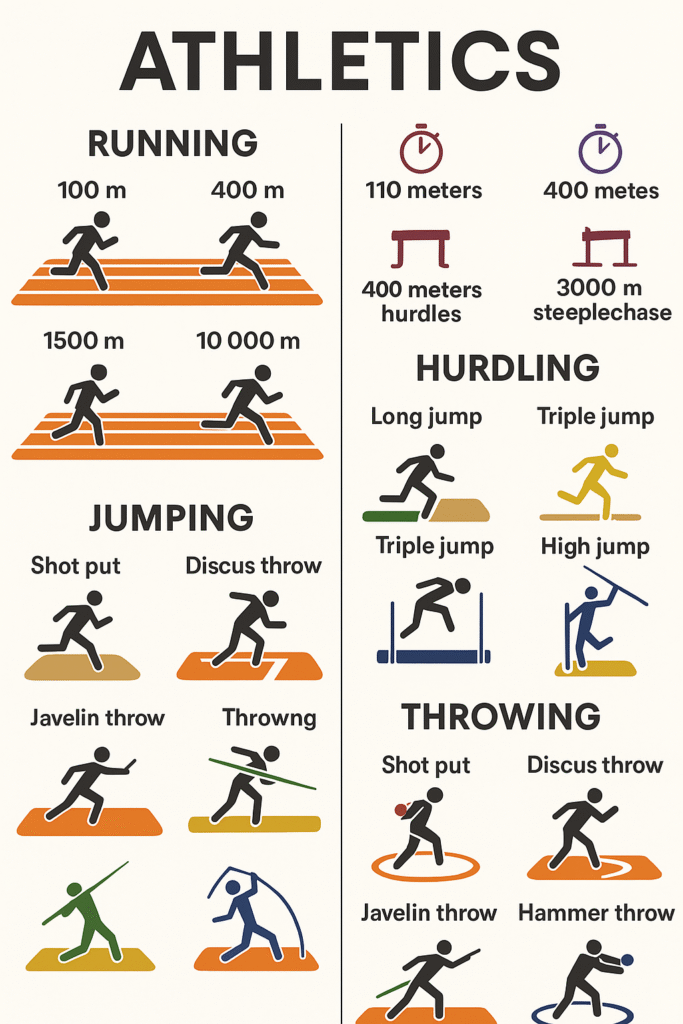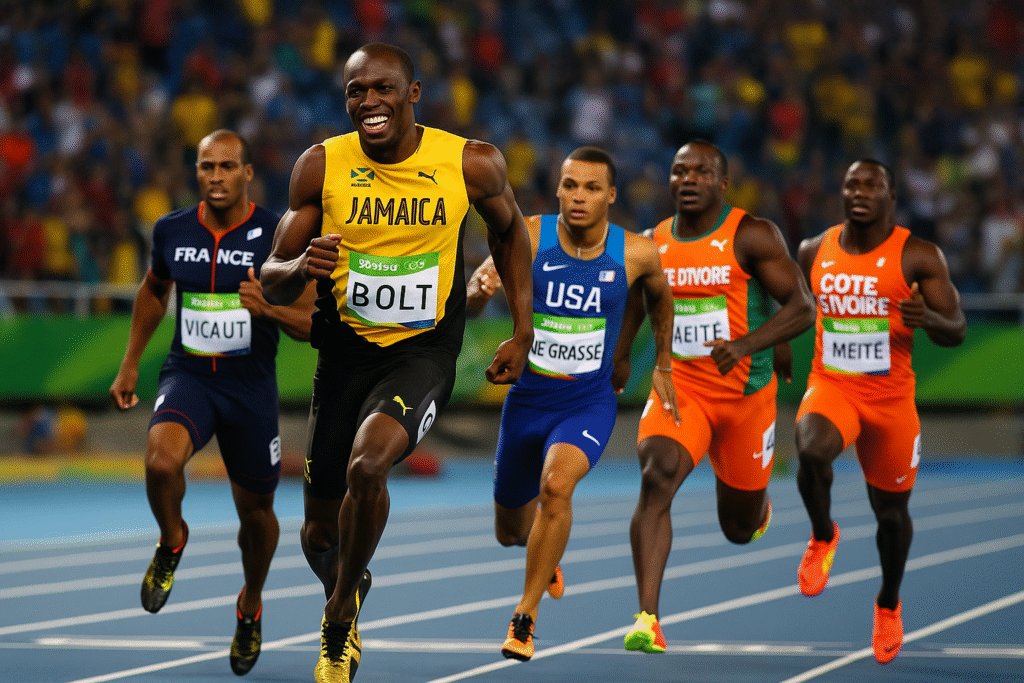Track and field (Athletics) is a collection of sporting events that involve running, walking, jumping, and throwing. These contests form the core of the Olympic and World Championship programs. Athletics has become one of the most international sports, with athletes from nearly every country competing on the global stage. The sport is featured in major competitions that attract huge audiences. Modern meets are usually held on a standard oval track (400m) with adjacent areas for jumps and throws.
Athletics History and Origins
The roots of athletics can be traced to ancient civilizations. Early organized contests involving running and throwing appear in Egyptian and Asian cultures millennia ago. The first recorded sports festival including track and field was the ancient Greek Olympics (776 BCE), which featured running races and the pentathlon. (In Ireland, the Tailteann Games of 1829 BCE also had early track contests.) Modern athletics took shape in 19th-century Britain through new clubs and national meets.
- Ancient to 19th Century: Early running and jumping contests (Greek Olympics 776 BCE); first track clubs in England (Cambridge 1857, Oxford 1860) and national championships (AAA in 1880).
- Olympic Era: Athletics featured prominently at Athens 1896, helping standardize the sport worldwide. The revival of the modern Olympics gave athletics a truly global platform.
- Global Organization: In 1912 the International Amateur Athletic Federation (IAAF) was founded to govern track and field. This provided global structure (it was renamed World Athletics in 2019). Women’s athletics events were added to the Olympic program in 1928, marking the sport’s expanding reach.
Athletics Events and Disciplines
Competitions in track-and-field comprise three main categories: track events, field events, and combined events. Track events involve races around the oval track (from short sprints up to 10,000 m) and obstacle races like the hurdles and steeplechase. Field events include jumping (long jump, triple jump, high jump, pole vault) and throwing (shot put, discus, javelin, hammer). Combined events (decathlon for men, heptathlon for women) span multiple disciplines with points scored in each.

- Track (Running): Short sprints (100m, 200m, 400m) and longer races (800m, 1500m, 5000m, 10,000m), plus hurdles (110m/100m hurdles, 400m hurdles) and the 3000m steeplechase. Relay races (4×100m, 4×400m) involve teams of four passing a baton.
- Field (Jumps): Long jump, triple jump, high jump, pole vault – athletes are measured by distance or height. A jump is a foul if the athlete steps beyond the take-off line or knocks down the bar.
- Field (Throws): Shot put, discus, javelin, hammer throw – competitors launch an implement for maximum distance. Fouls occur if athletes step out of the throwing circle or if the implement lands outside the designated sector.
Technical rules are tightly controlled. All sprints and races up to 400 m use marked lanes, and a false start (moving too soon after the gun) leads to immediate disqualification. World Athletics (the sport’s governing body) mandates standard track dimensions, hurdle heights, and implement weights. For example, reaction times faster than 0.1s after the gun are flagged as false starts. In field events, measurements are taken from a defined take-off point, and a single foot fault in the pit or circle invalidates the attempt.
Elite performances must also comply with anti-doping regulations. Any record-setting attempt is followed by drug tests before ratification. For instance, when Jamaican sprinter Usain Bolt ran 9.58 s for the 100 m (2009), his time was certified by officials and approved as a world record. Likewise, field athletes setting potential records must undergo post-competition testing. In this way, World Championships and Olympic results all adhere to strict international rules and ensure fair competition.
Athletics Global Competitions and Festivals
Track-and-field competitions run year-round at many levels. The sport’s marquee events include:
- Olympic Games: The centerpiece of global athletics. Track and field has been contested at every Summer Olympics since 1896. Events such as the Olympic 100 m final draw enormous attention worldwide. Nations send their best athletes to compete for medals on the global stage. Both men’s and women’s events are included.
- World Championships: Organized by the sport’s global governing body (formerly IAAF), this biennial meet crowns world champions in all Olympic track and field events. First held in 1983, the World Championships are second only to the Olympics in prestige. (There are separate editions indoors and out.)
- Continental and Regional Games: Many regions host their own athletics competitions. For example, the European Athletics Championships, African Championships, Asian Games athletics, and Pan-American Games each feature full track and field programs. Multisport events like the Commonwealth Games and Universiade also include athletics. These meets serve as “festivals” for regional athletes and follow the same event rules as the Olympics.
- Diamond League and One-Day Meets: The annual Diamond League (established in 2010) is a circuit of the world’s top Athletics meets (e.g. in Doha, Shanghai, Eugene, Oslo, Monaco, London). Athletes earn points at each meeting toward a final championship. This series, sanctioned by World Athletics, showcases elite competition outside the championship calendar. Other famous one-day meets include the Prefontaine Classic (USA) and Athletissima (Switzerland).
You can read about Olympics
All these competitions use the same rules and equipment standards. Winners are determined by fastest times or longest jumps/throws, under the supervision of international-level officials. As journalistic coverage emphasizes, these global athletics festivals unite fans and nations. Spectators worldwide tune in to see world records challenged and underdog stories unfold. The World Championships in Athletics, for example, is one of the largest sporting events on earth, with stadiums celebrating both athletic excellence and national pride.
Athletics: Famous Teams and Athletes
Track-and-field history is rich with legendary competitors. Some of the most celebrated include:

- Usain Bolt (Jamaica): Widely regarded as the fastest man ever. Bolt won three consecutive Olympic 100 m/200 m doubles (2008, 2012, 2016) and set world records of 9.58 s (100 m) and 19.19 s (200 m). He earned 8 Olympic golds and 11 world titles, becoming the sport’s superstar.
- Allyson Felix (USA): The most decorated track athlete in history. Felix collected 11 Olympic medals (7 gold) and 18 World Championship medalsen.wikipedia.org. She won Olympic titles in the 200 m and anchored U.S. relay teams, and her longevity made her a global icon.
- Eliud Kipchoge (Kenya): Legendary marathoner. He won Olympic marathon gold in 2016 and 2020, and held the official world record (2:01:09) from 2018–2023. In a famous exhibition (“INEOS 1:59 Challenge”) he ran 1:59:40, showing the endurance extreme of athletics.
- Liu Xiang (China): Hurdles champion. Liu won the 110 m hurdles gold at Athens 2004 (12.91 s, tying the world record)en.wikipedia.org. He later set a new world record at 12.88 s in 2006, inspiring a generation of Asian track athletes.
- Sir Mo Farah (Great Britain): Distance great. Farah earned four Olympic golds (5,000 m and 10,000 m at both 2012 and 2016) and six World Championship golds. His “double-double” (winning both events at two Games in a row) made him the most successful male distance runner ever.
- Sergey Bubka (Ukraine/USSR): Pole vault legend. He won one Olympic gold (1988) and six world titles, and broke the pole vault world record 35 times, dominating the event for years.
Each country fields a “team” at major events, and some have storied track & field traditions. For example, Team USA has historically led the Olympic medal table in athletics, while Jamaica’s sprint team and Kenya’s distance runners have also dominated their specialties. (Relay teams, such as the USA 4×100 m, often become symbols of teamwork.) These athletes and teams humanize the sport – commentators highlight Bolt’s trademark victory poses, Felix’s grit through many championships, and Farah’s dramatic finishing kicks. Each meet tells a human story of competition, national pride, and sportsmanship.
Athletics in the Future
Looking ahead, track and field (Athletics) will continue evolving on a global stage. World Athletics is exploring changes to keep the sport modern and engaging (for example, adding mixed-gender relay events and adjusting race formats). Technology – such as faster tracks, improved shoes, and detailed data analytics – may lead to even faster times and higher jumps. Many nations (e.g. China, Japan, Qatar) are investing heavily in development programs, while traditional powers keep raising their standards. At the same time, anti-doping measures and governance reforms aim to protect the sport’s integrity and public trust.
Ultimately, Athletics remains a timeless showcase of human speed and strength. On every continent – from small local meets to grand international stadiums – people will continue to chase records and medals under a common set of rules. Track and field’s deep history and global reach mean it will stay a centerpiece of sports culture worldwide.
Sources: Authoritative histories and statistics en.wikipedia.org
